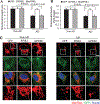PINK1 Activation Attenuates Impaired Neuronal-Like Differentiation and Synaptogenesis and Mitochondrial Dysfunction in Alzheimer's Disease Trans-Mitochondrial Cybrid Cells
- PMID: 33998543
- PMCID: PMC9004622
- DOI: 10.3233/JAD-210095
PINK1 Activation Attenuates Impaired Neuronal-Like Differentiation and Synaptogenesis and Mitochondrial Dysfunction in Alzheimer's Disease Trans-Mitochondrial Cybrid Cells
Abstract
Background: Mitochondrial dysfunction, bioenergetic deficit, and extensive oxidative stress underlie neuronal perturbation during the early stage of Alzheimer's disease (AD). Previously, we demonstrated that decreased PTEN-induced putative kinase 1 (PINK1) expression is associated with AD pathology in AD-affected human brains and AD mice.
Objective: In the present study, we highlight the essential role of PINK1 in AD-relevant mitochondrial perturbation and neuronal malfunction.
Methods: Using trans-mitochondrial "cybrid" (cytoplasmic hybrid) neuronal cells, whose mitochondria are transferred from platelets of patients with sporadic AD, we observed the effect of PINK1 in neuronal-like differentiation and synaptogenesis and mitochondrial functions.
Results: In AD cybrid cells, the downregulation of PINK1 is correlated to the alterations in mitochondrial morphology and function and deficit in neuronal-like differentiation. Restoring/increasing PINK1 by lentivirus transduction of PINK1 robustly attenuates mitochondrial defects and rescues neurite-like outgrowth. Importantly, defective PINK1 kinase activity fails to reverse these detrimental effects. Mechanistically, AD cybrid cells reveal a significant decrease in PINK1-dependent phosphorylated mitofusin (Mfn) 2, a key mitochondrial membrane protein that participates in mitochondrial fusion, and an insufficient autophagic activity for the clearance of dysfunctional mitochondria. Overexpression of PINK1, but not mutant PINK1 elevates phosphorylation of Mfn2 and autophagy signaling LC3-II. Accordingly, PINK1-overexpressed AD cybrids exhibit increases in mitochondrial length and density and suppressed reactive oxygen species. These results imply that activation of PINK1 protects against AD-affected mitochondrial dysfunction and impairment in neuronal maturation and differentiation.
Conclusion: PINK1-mediated mitophagy is important for maintaining mitochondrial health by clearance of dysfunctional mitochondria and therefore, improves energy homeostasis in AD.
Keywords: Alzheimer’s disease; PINK1; cybrid cells; mitochondrial dysfunction; mitophagy.
Figures





References
-
- Ryman DC, Acosta-Baena N, Aisen PS, Bird T, Danek A, Fox NC, Goate A, Frommelt P, Ghetti B, Langbaum JB, Lopera F, Martins R, Masters CL, Mayeux RP, McDade E, Moreno S, Reiman EM, Ringman JM, Salloway S, Schofield PR, Sperling R, Tariot PN, Xiong C, Morris JC, Bateman RJ, Dominantly Inherited Alzheimer Network (2014) Symptom onset in autosomal dominant Alzheimer disease: A systematic review and meta-analysis. Neurology 83, 253–260. - PMC - PubMed
-
- Ittner LM, Gotz J (2011) Amyloid-beta and tau–a toxic pas de deux in Alzheimer’s disease. Nat Rev Neurosci 12, 65–72. - PubMed
-
- Pascoal TA, Mathotaarachchi S, Mohades S, Benedet AL, Chung CO, Shin M, Wang S, Beaudry T, Kang MS, Soucy JP, Labbe A, Gauthier S, Rosa-Neto P (2017) Amyloid-beta and hyperphosphorylated tau synergy drives metabolic decline in preclinical Alzheimer’s disease. Mol Psychiatry 22, 306–311. - PMC - PubMed
Publication types
MeSH terms
Substances
Grants and funding
LinkOut - more resources
Full Text Sources
Other Literature Sources
Medical
Research Materials

